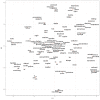Identifying and Predicting Intentional Self-Harm in Electronic Health Record Clinical Notes: Deep Learning Approach
- PMID: 32729840
- PMCID: PMC7426805
- DOI: 10.2196/17784
Identifying and Predicting Intentional Self-Harm in Electronic Health Record Clinical Notes: Deep Learning Approach
Abstract
Background: Suicide is an important public health concern in the United States and around the world. There has been significant work examining machine learning approaches to identify and predict intentional self-harm and suicide using existing data sets. With recent advances in computing, deep learning applications in health care are gaining momentum.
Objective: This study aimed to leverage the information in clinical notes using deep neural networks (DNNs) to (1) improve the identification of patients treated for intentional self-harm and (2) predict future self-harm events.
Methods: We extracted clinical text notes from electronic health records (EHRs) of 835 patients with International Classification of Diseases (ICD) codes for intentional self-harm and 1670 matched controls who never had any intentional self-harm ICD codes. The data were divided into training and holdout test sets. We tested a number of algorithms on clinical notes associated with the intentional self-harm codes using the training set, including several traditional bag-of-words-based models and 2 DNN models: a convolutional neural network (CNN) and a long short-term memory model. We also evaluated the predictive performance of the DNNs on a subset of patients who had clinical notes 1 to 6 months before the first intentional self-harm event. Finally, we evaluated the impact of a pretrained model using Word2vec (W2V) on performance.
Results: The area under the receiver operating characteristic curve (AUC) for the CNN on the phenotyping task, that is, the detection of intentional self-harm in clinical notes concurrent with the events was 0.999, with an F1 score of 0.985. In the predictive task, the CNN achieved the highest performance with an AUC of 0.882 and an F1 score of 0.769. Although pretraining with W2V shortened the DNN training time, it did not improve performance.
Conclusions: The strong performance on the first task, namely, phenotyping based on clinical notes, suggests that such models could be used effectively for surveillance of intentional self-harm in clinical text in an EHR. The modest performance on the predictive task notwithstanding, the results using DNN models on clinical text alone are competitive with other reports in the literature using risk factors from structured EHR data.
Keywords: deep learning; electronic health records; machine learning; natural language processing; suicide; suicide, attempted.
©Jihad S Obeid, Jennifer Dahne, Sean Christensen, Samuel Howard, Tami Crawford, Lewis J Frey, Tracy Stecker, Brian E Bunnell. Originally published in JMIR Medical Informatics (http://medinform.jmir.org), 30.07.2020.
Conflict of interest statement
Conflicts of Interest: JD is co-owner of the Behavioral Activation Tech LLC, a company that develops technology-based treatments for depression.
Figures



References
-
- Kochanek KD, Murphy S, Xu J, Arias E. Mortality in the United States, 2016. NCHS Data Brief. 2017 Dec;(293):1–8. http://www.cdc.gov/nchs/data/databriefs/db293.pdf - PubMed
-
- Fatal Injury Data. Centers for Disease Control and Prevention. [2019-12-02]. https://www.cdc.gov/injury/wisqars/fatal.html.
-
- Preventing Suicide. Centers for Disease Control and Prevention. [2019-12-02]. https://www.cdc.gov/violenceprevention/suicide/fastfact.html.
Grants and funding
LinkOut - more resources
Full Text Sources

